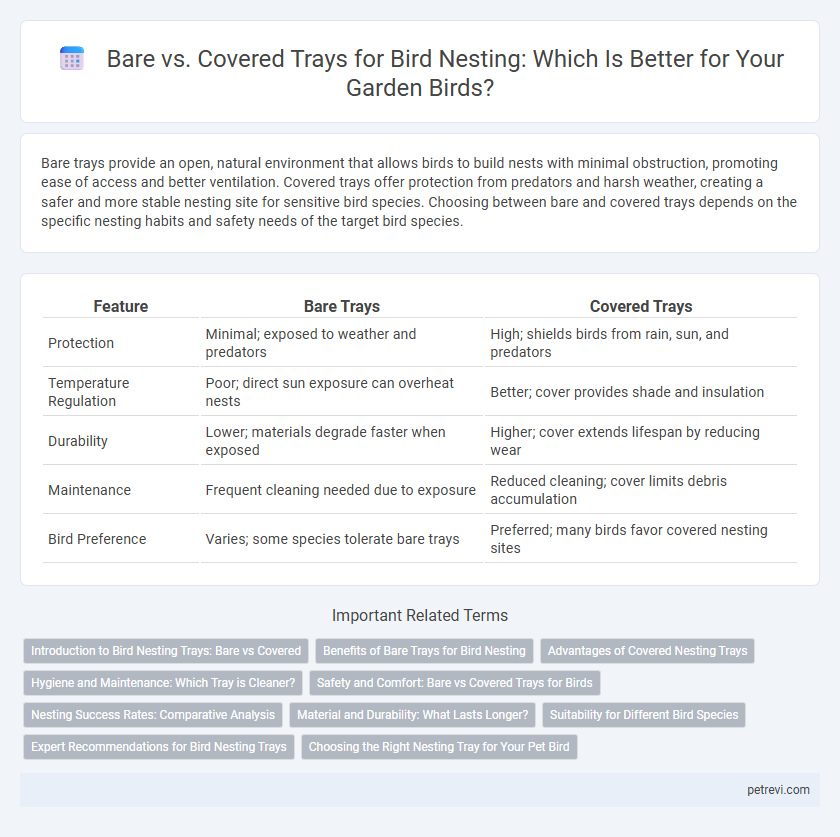Bare trays provide an open, natural environment that allows birds to build nests with minimal obstruction, promoting ease of access and better ventilation. Covered trays offer protection from predators and harsh weather, creating a safer and more stable nesting site for sensitive bird species. Choosing between bare and covered trays depends on the specific nesting habits and safety needs of the target bird species.
Table of Comparison
| Feature | Bare Trays | Covered Trays |
|---|---|---|
| Protection | Minimal; exposed to weather and predators | High; shields birds from rain, sun, and predators |
| Temperature Regulation | Poor; direct sun exposure can overheat nests | Better; cover provides shade and insulation |
| Durability | Lower; materials degrade faster when exposed | Higher; cover extends lifespan by reducing wear |
| Maintenance | Frequent cleaning needed due to exposure | Reduced cleaning; cover limits debris accumulation |
| Bird Preference | Varies; some species tolerate bare trays | Preferred; many birds favor covered nesting sites |
Introduction to Bird Nesting Trays: Bare vs Covered
Bare bird nesting trays provide an open, exposed platform that simulates natural nesting sites like tree branches or cliff ledges, allowing for easy access and monitoring. Covered nesting trays offer protection from predators and harsh weather through built-in roofs or partial enclosures, creating a safer environment for eggs and chicks. Choosing between bare and covered trays depends on species-specific nesting habits and local environmental conditions to optimize breeding success.
Benefits of Bare Trays for Bird Nesting
Bare trays provide birds with a natural substrate that encourages instinctive nest-building behaviors and allows better drainage, reducing the risk of mold and parasites. These trays offer enhanced airflow, creating a healthier microenvironment for eggs and hatchlings. The simplicity of bare trays supports diverse bird species' needs by accommodating a wide range of nesting materials and styles.
Advantages of Covered Nesting Trays
Covered nesting trays provide enhanced protection against predators and harsh weather conditions, ensuring higher safety and comfort for bird nests. These trays help maintain optimal temperature and humidity levels, promoting better egg incubation and chick development. Furthermore, covered designs reduce exposure to direct sunlight and rain, increasing the likelihood of successful breeding cycles.
Hygiene and Maintenance: Which Tray is Cleaner?
Bare trays for bird nesting often provide easier cleaning due to their smooth surfaces, reducing the buildup of dirt, droppings, and bacteria. Covered trays can trap moisture and debris underneath, potentially promoting mold growth and requiring more frequent, thorough maintenance. Therefore, bare trays tend to offer a cleaner and more hygienic environment for bird nesting.
Safety and Comfort: Bare vs Covered Trays for Birds
Covered trays provide enhanced safety by protecting bird nests from predators and harsh weather, creating a secure environment for eggs and chicks. Bare trays, while offering better ventilation and easier observation, expose nests to greater risks of temperature fluctuations and potential threats. Choosing between bare and covered trays depends on species-specific nesting habits, with covered options often favored for comfort and protection in vulnerable bird populations.
Nesting Success Rates: Comparative Analysis
Studies show that covered trays for bird nesting yield higher nesting success rates, with hatchling survival improving by up to 25% compared to bare trays. Covered trays provide enhanced protection from predators and environmental stressors, creating a safer microhabitat for eggs and chicks. Bare trays, although simpler, expose nests to increased risks such as temperature fluctuations and predation, negatively impacting overall reproductive outcomes.
Material and Durability: What Lasts Longer?
Bare trays for bird nesting, often made from untreated wood or metal, offer natural breathability but are prone to weathering and decay, reducing their durability over time. Covered trays, typically coated with protective materials like plastic, resin, or weather-resistant paint, provide enhanced longevity by shielding against moisture, UV rays, and pests. Choosing covered trays extends the lifespan of nesting sites, especially in harsh outdoor conditions where material degradation is a significant concern.
Suitability for Different Bird Species
Bare trays provide an open, minimalist nesting environment favored by species such as swallows and martins that prefer exposed nesting sites. Covered trays offer shelter and protection, making them suitable for cavity-nesting birds like bluebirds, chickadees, and woodpeckers that require enclosed spaces. Selecting the appropriate tray design based on species-specific nesting behaviors increases the likelihood of successful breeding and chick survival.
Expert Recommendations for Bird Nesting Trays
Experts recommend covered trays for bird nesting as they provide enhanced protection from predators and harsh weather conditions, promoting higher nesting success rates. Bare trays, while easier to clean and monitor, may expose nests to increased risk and stress, potentially reducing breeding outcomes. Optimal tray choice depends on the target bird species' natural nesting habits and the local environmental threats.
Choosing the Right Nesting Tray for Your Pet Bird
Choosing the right nesting tray for your pet bird depends on species-specific needs, with bare trays offering easy cleaning and monitoring, ideal for birds that prefer open spaces, while covered trays provide privacy and a sense of security, mimicking natural nesting environments for species sensitive to disturbances. Material quality and ventilation are crucial factors to ensure durability and optimal airflow, preventing mold and maintaining egg health. Understanding your bird's nesting behavior and habitat preferences enhances breeding success and overall well-being.
Bare vs Covered trays for Bird nesting Infographic

 petrevi.com
petrevi.com